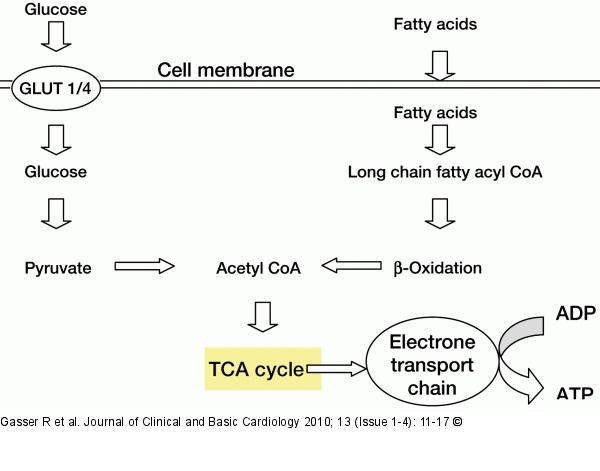Gasser R, Roessl U, Holzwart E, Ablasser K, Friehs I, Lewinski D, Pieske B, Mächler H, Trantiner-Yates A, Tscheliessnig KH, Mangge H, Gasser S Shift from Adult to Fetal Metabolic Phenotype During Prolonged Experimental Myocardial Ischemia: A Study on the Effect of Beta Blockers upon Gene Expression of Transmembrane Glucose Transporters Journal of Clinical and Basic Cardiology 2009; 12 (1-4): 11-17 PDF Summary Overview
| ||||||||||||
Figure/Graphic 3: Myocardial Metabolism Substrates of myocardial metabolism. Mod. from [29, 32]. The fetal myocardial phenotype uses predominantly glucose for its metabolism, whereas the adult individual mainly metabolises fatty acids. During special conditions, like hypoxia, the adult phenotype of myocardial metabolism converts to the fetal phenotype, again preferably using glucose for its metabolism (Fig. 4). It has been shown that a preferentially glucose-oriented cardiac metabolism is beneficial in myocardial ischemia. However, knockout experiments have shown that successful transfer to the fetal metabolism is possible only under adequate/increased GLUT1 expression [33–35]. |

Figure/Graphic 3: Myocardial Metabolism
Substrates of myocardial metabolism. Mod. from [29, 32]. The fetal myocardial phenotype uses predominantly glucose for its metabolism, whereas the adult individual mainly metabolises fatty acids. During special conditions, like hypoxia, the adult phenotype of myocardial metabolism converts to the fetal phenotype, again preferably using glucose for its metabolism (Fig. 4). It has been shown that a preferentially glucose-oriented cardiac metabolism is beneficial in myocardial ischemia. However, knockout experiments have shown that successful transfer to the fetal metabolism is possible only under adequate/increased GLUT1 expression [33–35]. |






